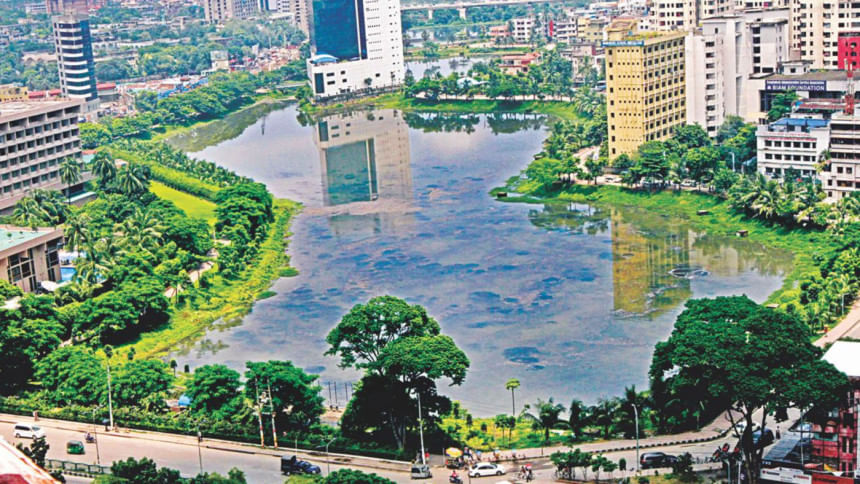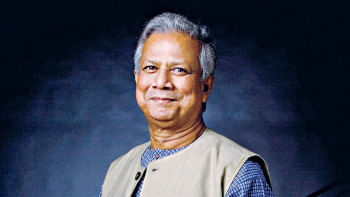Nature-based solutions for our towns and cities

When we talk about nature-based solutions (NbS)—that is protecting, managing, restoring or creating ecosystems for the benefit of the people and biodiversity—we almost always think of wilderness or rural areas. We think of famous forests like the Sundarbans, large wetlands like Hakaluki Haor or Chalan Beel, or impressive plantations of the Bangladesh Forest Department, NGOs, and villagers throughout the country.
But what about our cities and towns? Can we have any NbS for them?
Of course we can. And, in fact, we already have many. If we take Hatirjheel Integrated Development Project in Dhaka—an approximately USD 250 million project which ran for six years—it basically mixed both engineered infrastructure and NbS. The restored jheel (wetland) and Begunbari khal have improved storm-water management of Dhaka and made aquatic biodiversity better. It also increased green and open space in our busy capital.
Unfortunately, a study done in 2012 showed that Dhaka lost 46 percent of its green space between 1975 and 2005. In the last 15 years, Dhaka has expanded a lot—both vertically and horizontally. So, the loss as well as the gain of greenery have happened, especially on the city edges.
The benefits of green, open spaces in our cities are many. These spaces and parks improve mental and physical health of urbanites, create informal networks among the visitors, and offer livelihood opportunities for many fellow city dwellers. Some of these green spaces are landmarks of our cities: Bell's Park of Barishal, Central Railway Building area of Chittagong, Ramna Park of Dhaka, Shahid Hadis Park of Khulna, and Shimla Park of Rajshahi.
But creating biodiversity-rich green spaces is not the only NbS we can have in urban areas. The Network Nature (www.networknature.eu) has recently captured some fantastic work done in cities around the world showing diversity in urban NbS: combining green and blue infrastructure in different European cities to make them biodiverse and healthy; installing green roofs in Basel, Switzerland, for climate change mitigation and adaptation; and creating Yanweizhou Wetland Park in Jinhua, China, as a part of resilient landscape, are a few examples.
Now, let us shift our focus from large cities to our small towns, especially those which are vulnerable to climate change. If we can restore the degraded wetlands outside such towns, storm-water could get stored there without causing waterlogging. Similarly, if we re-excavate the natural drainage networks within these towns, which got encroached or blocked for different reasons, rainwater can easily pass through urban settlements.
A coastal town can also benefit from having a mangrove belt looking over the Bay of Bengal. Such stretches of mangroves can reduce high wind speeds as well as protect a town from coastal floods. Similarly, for a town located by a river, as many of our towns are, especially those with river ports, we can think of NbS along with concrete blocks, gabion walls or embankments to protect it. We can create riparian vegetation outside these grey infrastructure, which will act as the first line of defence to rising flood water and erosion. Such NbS will also increase the longevity of engineered infrastructure and reduce its maintenance costs. Some towns like Sirajganj may not be protected exclusively by NbS from the aggressive Jamuna, but many towns facing lesser aggression from rivers could.
If we want NbS to improve the living conditions of our towns and cities, especially under changing climate, we need to remember three key issues.
First, our municipalities, city corporations, and development partners should ensure that NbS is an integral part of urban development strategies. Urban planning can play a crucial role to support the implementation of NbS and can synergise the existing and new benefits an NbS expects to bring in. It can also help to address prevailing conflicts over resources and ensure that social equity is properly attended to with an increase in urban slums. For effective and sustainable impact, local institutions and communities also should be appropriately and sufficiently involved in designing, implementing, and monitoring an NbS activity in our towns.
Bangladesh has a long experience of engaging local communities and institutions in natural resource management, climate change adaptation, and ecosystem-based adaptation following participatory approaches. Therefore, we can indeed adopt and implement NbS effectively and efficiently in the urban context.
Second, our funding and implementing agencies should follow available standards and guidelines for NbS while designing and implementing NbS projects in urban areas. We should remember that, to call an intervention NbS, it must benefit both humans and the biodiversity, not just one or the other. A single-row roadside plantation with one type of exotic tree species, therefore, is not an NbS.
The IUCN Global Standard for NbS (2020) brings together experiences from 100 countries gathered over two years. This standard questions us if we sufficiently understand our urban problems and helps us to design an NbS at appropriate scale matching the depth of the problems. Among others, this standard guides us to check if an NbS is economically viable, offering sufficient biodiversity and ecosystem benefits, and involving all stakeholders effectively, who understand and agree on the potential benefits to be received from an NbS.
Third, it is crucial that an NbS management system is embedded within our urban local governments to follow up on the urban NbS beyond the project tenure. Unlike an engineering solution, an NbS takes time to show its full potential. We therefore need to manage the NbS based on evidence gathered through regular monitoring and evaluation under the ever-changing socio-economic and climatic conditions. We also need to measure the effectiveness of an NbS: how it is contributing to improve urban resilience to climate change, for example. These post-project lessons will not only help an implemented NbS to work better, but also help us to replicate the same elsewhere as a good practice.
Bangladesh has started 2021 with new opportunities for urban NbS. The government's 8th Five Year Plan (2020−2025) has incorporated elements of nature-based approaches and interventions in its Urban Development Strategy, especially keeping in mind the need for improving urban environment and building resilience to disasters and climate change. To transform Bangladesh into a "climate resilient delta nation", the Perspective Plan of Bangladesh 2021-2041—a plan to make Bangladesh a high-income country—also realises the need for synergising interventions in urban and environmental sectors.
Both these national plans were approved last year—the year troubled by the on-going covid pandemic. Now it is time to see how these strategies and plans support urban NbS on the ground, especially in our climate-vulnerable cities and towns.
Dr Haseeb Md Irfanullah is an independent consultant working on environment, climate change, and research systems. His Twitter handle is: @hmirfanullah

 For all latest news, follow The Daily Star's Google News channel.
For all latest news, follow The Daily Star's Google News channel. 



Comments